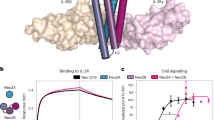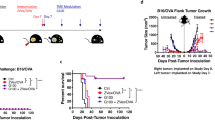Abstract
Local cytokine concentrations are required for inhibition of tumor growth with less toxic side-effects. However, genetically engineered tumor cells secreting cytokines still induce toxicity and activate bystander cells. To circumvent such problems, membrane-bound forms of IL-4 (IL-4m) were expressed on MethA fibrosarcoma tumor cells. Chimeric forms of IL-4 with the type I transmembrane protein CD4 or type II transmembrane protein TNF were designed to express IL-4 in opposite orientations on the tumor cell surface. The IL-4m on tumor clones was able to support cell growth of the IL-4 dependent cytotoxic cell line (CT.4S) and the Th2 cell clone (D10). Furthermore, the IL-4m tumor clones stimulated proliferation of 2C TCR transgenic spleen cells which are responsive to Ld MHC class I molecules. Expression of the IL-4/TNF chimeric protein on MethA cells elicited antitumor immunity and protected from MethA tumor challenge. The proposed tumor vaccine may serve as an effective gene therapy method to avoid the toxicity of recombinant cytokines and bulk bystander leukocyte stimulation encountered in conventional cytokine gene therapy.
This is a preview of subscription content, access via your institution
Access options
Subscribe to this journal
Receive 12 print issues and online access
$259.00 per year
only $21.58 per issue
Buy this article
- Purchase on Springer Link
- Instant access to full article PDF
Prices may be subject to local taxes which are calculated during checkout





Similar content being viewed by others
References
Oppenheim JJ, Zachariae CO, Mukaida N, Matsushima K . Properties of the novel proinflammatory supergene ‘intercrine’ cytokine family Annu Rev Immunol 1991 9: 617–648
Lloyd AR, Oppenheim JJ . Poly's lament: the neglected role of the polymorphonuclear neutrophil in the afferent limb of the immune response Immunol Today 1992 13: 169–172
Colombo MP, Modesti A, Parmiani G, Forni G . Local cytokine availability elicits tumor rejection and systemic immunity through granulocyte-T-lymphocyte cross-talk Cancer Res 1992 52: 4853–4857
Modesti A et al. Ultrastructural evidence of the mechanisms responsible for interleukin-4-activated rejection of a spontaneous murine adenocarcinoma Int J Cancer 1993 53: 988–993
Siegel JP, Puri RK . Interleukin-2 toxicity J Clin Oncol 1991 9: 694–704
Cohen J . IL-12 deaths: explanation and a puzzle Science 1995 270: 908
Tracey KJ et al. Shock and tissue injury induced by recombinant human cachectin Science 1986 234: 470–474
Golumbek PT et al. Treatment of established renal cancer by tumor cells engineered to secrete interleukin-4 Science 1991 254: 713–716
Forni G et al. Cytokine-induced tumor immunogenicity: from exogenous cytokines to gene therapy J Immunother 1993 14: 253–257
Tepper RI, Mule JJ . Experimental and clinical studies of cytokine gene-modified tumor cells Hum Gene Ther 1994 5: 153–164
Pardoll DM . Paracrine cytokine adjuvants in cancer immunotherapy Annu Rev Immunol 1995 13: 399–415
Allione A et al. Immunizing and curative potential of replicating and nonreplicating murine mammary adenocarcinoma cells engineered with interleukin(IL)-2, IL-4, IL-6, IL-7, IL-10, tumor necrosis factor alpha, granulocyte–macrophage colony-stimulating factor, and gamma-interferon gene or admixed with conventional adjuvants Cancer Res 1994 54: 6022–6026
Dranoff G et al. Vaccination with irradiated tumor cells engineered to secrete murine granulocyte–macrophage colony-stimulating factor stimulates potent, specific, and long-lasting anti-tumor immunity Proc Natl Acad Sci USA 1993 90: 3539–3543
Tjuvajev J et al. RG-2 glioma growth attenuation and severe brain edema caused by local production of interleukin-2 and interferon-γ Cancer Res 1995 55: 1902–1910
Lollini PL et al. Systemic effects of cytokines released by gene-transduced tumor cells: marked hyperplasia induced in small bowel by γ-interferon transfectants through host's lymphocytes Int J Cancer 1995 61: 425–430
Nahill SR, Welsh RM . High frequency of cross-reactive cytotoxic T lymphocytes elicited during the virus-induced polyclonal cytotoxic T lymphocyte response J Exp Med 1993 177: 317–327
Zheng P, Liu Y . Costimulation by B7 modulates specificity of cytotoxic T lymphocytes: a missing link that explains some bystander T cell activation J Exp Med 1997 186: 1787–1791
Tough DF, Borrow P, Sprent J . Induction of bystander T cell proliferation by viruses and type I interferon in vivo Science 1996 272: 1947–1950
Rivoltini L et al. In vivo interleukin 2-induced activation of lymphokine-activated killer cells and tumor cytotoxic T-cells in cervical lymph nodes of patients with head and neck tumors Cancer Res 1990 50: 5551–5557
Colombo MP, Forni G . Immunotherapy I: cytokine gene transfer strategies Cancer Metast Rev 1997 16: 421–432
Forni G et al. Interleukin 2 activated tumor inhibition in vivo depends on the systemic involvement of host immunoreactivity J Immunol 1987 138: 4033–4041
Bosco M et al. Low doses of IL-4 injected perilymphatically in tumor-bearing mice inhibit the growth of poorly and apparently nonimmunogenic tumors and induce a tumor-specific immune memory J Immunol 1990 145: 3136–3143
Kurt-Jones EA, Fiers W, Pober JS . Membrane interleukin 1 induction on human endothelial cells and dermal fibroblasts J Immunol 1987 139: 2317–2324
Kriegler M et al. A novel form of TNF/cachectin is a cell surface cytotoxic transmembrane protein: ramifications for the complex physiology of TNF Cell 1988 53: 45–53
Browning JL et al. Lymphotoxin beta, a novel member of the TNF family that forms a heteromeric complex with lymphotoxin on the cell surface Cell 1993 72: 847–856
Assenmacher M et al. Specific expression of surface interferon-gamma on interferon-gamma producing T cells from mouse and man Eur J Immunol 1996 26: 263–267
Kaplan D . Autocrine secretion and the physiological concentration of cytokines Immunol Today 1996 17: 303–304
Lou J, Dayer JM, Grau GE, Burger D . Direct cell/cell contact with stimulated T lymphocytes induces the expression of cell adhesion molecules and cytokines by human brain microvascular endothelial cells Eur J Immunol 1996 26: 3107–3113
Karasuyama H, Melchers F . Establishment of mouse cell lines which constitutively secrete large quantities of interleukin 2, 3, 4 or 5, using modified cDNA expression vectors Eur J Immunol 1988 18: 97–104
Schuler T et al. T helper cell type 1-associated and cytotoxic T lymphocyte-mediated tumor immunity is impaired in interleukin 4-deficient mice J Exp Med 1999 189: 803–810
Quentmeier H, Klaucke J, Muhlradt PF, Drexler HG . Role of IL-6, IL-2, and IL-4 in the in vitro induction of cytotoxic T cells J Immunol 1992 149: 3316–3320
Liu B, Podack ER, Allison JP, Malek TR . Generation of primary tumor-specific CTL in vitro to immunogenic and poorly immunogenic mouse tumors J Immunol 1996 156: 1117–1125
Tepper RI, Pattengale PK, Leder P . Murine interleukin-4 displays potent anti-tumor activity in vivo Cell 1989 57: 503–512
Tepper RI, Coffman RL, Leder P . An eosinophil-dependent mechanism for the antitumor effect of interleukin-4 Science 1992 257: 548–551
Rossner P et al. Genetically modified tumour vaccines: insertion of the IL-2 gene downregulates tumorigenicity more efficiently than insertion of the CD80 gene Int J Oncol 1997 10: 77–82
Bretscher P, Cohn M . A theory of self–nonself discrimination Science 1970 169: 1042–1049
Lafferty KJ, Prowse SJ, Simeonovic CJ, Warren HS . Immunobiology of tissue transplantation: a return to the passenger leukocyte concept Annu Rev Immunol 1983 1: 143–173
Mueller DL, Jenkins MK, Schwartz RH . Clonal expansion versus functional clonal inactivation: a costimulatory signalling pathway determines the outcome of T cell antigen receptor occupancy Annu Rev Immunol 1989 7: 445–480
Scwartz RH . A cell culture model for T lymphocyte clonal anergy Science 1990 248: 1349–1356
Boussiotis VA et al. Prevention of T cell anergy by signaling through the γ-chain of the IL-2 receptor Science 1994 266: 1039–1042
Townsend SE, Allison JP . Tumor rejection after direct costimulation of CD8+ T cells by B7-transfected melanoma cells Science 1993 259: 368–370
Lin WC et al. Constitutive production of IL-2 by human carcinoma cells, expression of IL-2 receptor, and tumor cell growth J Immunol 1995 155: 4805–4816
Monastra G et al. Membrane form of TNF alpha induces both cell lysis and apoptosis in susceptible target cells Cell Immunol 1996 171: 102–110
Lucas R et al. Crucial role of tumor necrosis factor (TNF) receptor 2 and membrane-bound TNF in experimental cerebral malaria Eur J Immunol 1997 27: 1719–1725
Marr RA et al. Tumor immunotherapy using an adenoviral vector expressing a membrane-bound mutant of murine TNFα Gene Therapy 1997 4: 1181–1188
Soo Hoo W et al. Tumor cell surface expression of granulocyte–macrophage colony-stimulating factor elicits antitumor immunity and protects from tumor challenge in the P815 mouse mastocytoma tumor model J Immunol 1999 162: 7343–7349
Sha WC et al. Selective expression of an antigen receptor on CD8-bearing T lymphocytes in transgenic mice Nature 1988 335: 271–274
Kaye J et al. Both a monoclonal antibody and antisera specific for determinants unique to individual cloned helper T cell lines can substitute for antigen and antigen-presenting cells in the activation of T cells J Exp Med 1983 158: 836–856
Matis LA et al. Clonal analysis of the major histocompatibility complex restriction and the fine specificity of antigen recognition in the T cell proliferative response to cytochrome C J Immunol 1983 130: 1527–1535
Baron JL et al. Surface expression of alpha 4 integrin by CD4 T cells is required for their entry into brain parenchyma J Exp Med 1993 177: 57–68
Hu-Li J et al. Derivation of a T cell line that is highly responsive to IL-4 and IL-2 (CT.4R) and of an IL-2 hyporesponsive mutant of that line (CT.4S) J Immunol 1989 142: 800–807
Acknowledgements
The authors thank Drs Soon-Cheol Hong (Medical College of Ohio, OH) and Sang-Young Chun (Chonnam National University) for providing for CD4 and TNF cDNAs; Drs Charles Janeway jr (Yale University), and Peter Cresswell (Yale University) for providing anti-IL-4 and anti-MHC class I antibodies; and Mr Stephen Maher (Yale University) and Dr Jung Kyu Park (Chungnam National University) for assistance with FACS analysis. This work was supported by grant (KOSEF: 94–0403–14–02–3) to YSK and GM46367 from NIH to AB.
Author information
Authors and Affiliations
Rights and permissions
About this article
Cite this article
Kim, Y., Sonn, C., Paik, SG. et al. Tumor cells expressing membrane-bound form of IL-4 induce antitumor immunity. Gene Ther 7, 837–843 (2000). https://doi.org/10.1038/sj.gt.3301175
Received:
Accepted:
Published:
Issue Date:
DOI: https://doi.org/10.1038/sj.gt.3301175
Keywords
This article is cited by
-
Cancer Immunotherapy Using a Membrane-bound Interleukin-12 With B7-1 Transmembrane and Cytoplasmic Domains
Molecular Therapy (2012)
-
Antitumor immunity and vaccine effect induced by IL-12 synergizes B7-1 gene transfected cells
Chinese Journal of Cancer Research (2003)



